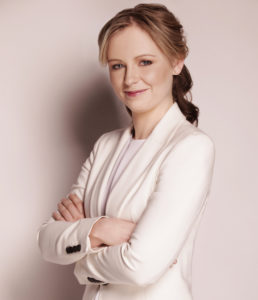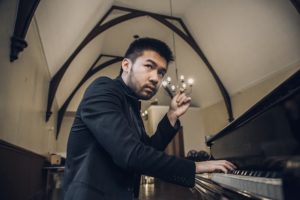When the stars are aligned
Great music, incisive conducting, fabulous soloist, enthusiastic musicians… yes, the stars aligned last Thursday night at Zellerbach Hall, where guest conductor Gemma New led pianist Conrad Tao and the Berkeley Symphony in an evening to savor.

Gemma New, a New Zealand-born conductor who trained in violin and then studied conducting at the Peabody Institute and under Dudamel at the LA Philharmonic, crafted a program of astonishing breadth and depth.
The sweep and romanticism of Rachmaninoff’s Rhapsody on a Theme of Paganini and the stark intensity of Liszt’s Totentanz were balanced by two works by living composers, Anna Clyne’s mesmerizing Abstractions and Rene Orth’s vivid Chasing Light, and each was a gift.
That was the breadth. The depth came from inner parallels in the works, with both of the piano works constructed around variations and each containing references to the thirteenth century plainchant, Dies Irae, the Day of Wrath. Another thread was the visual. Liszt’s phenomenally difficult work was based on Holbein’s woodcuts on Death, while Clyne’s Abstractions were written around five art pieces of serenity and severity.

They began the concert with the West Coast Premiere of Chasing Light. Orth was there in person and the tall Texan took the stage to explain her title. “I wrote this during a time of unrelenting pressure, trying to finish a chamber opera while working on this [commission]. I’m sure you all know what that’s like, and then to see the light at the end of the tunnel and try to get there.”
Deadline or no, the work was hugely propulsive, and at the end almost joyously so. New used big sharp gestures to keep the musicians tight, and the whole began to feel as train-like as Orth’s metaphor. The sharp regularity became wheels on tracks, while notes that bloomed in the middle conveyed a sense of close encounters at high speed.
Peremptory brass, manic flute, and lots of percussion all came together with a scale that curiously skips the middle notes for a feeling of stumbling up the stairs. After the high energy of this piece I will look forward to more compositions from this young composer.

And then Tao came out and gobsmacked us. The Rachmaninoff was as frolicsome as a yearling, but then turned stern with the Dies Irae countermelody. And then from stern to steamy! Rachmaninoff flipped his melody upside down to create one of the lushest moments of all Romanticism, before returning to piano pyrotechnics. What a performance! And Tao was not alone. Warmed up by the intensity of the first short piece, the Berkeley Symphony musicians were hyper-focused, treating us to warmth and nuance in the Rachmaninoff and to heavy lifting in the Liszt.

Clyne’s work was a thoughtful interlude between those two big piano numbers, an inquiry into texture in a black and white world. Based on five works of post-modern art, these five movements were a mercurial delight. “Marble Moon” was built on slow swells of sound in the basses, placid and pure-toned with winds and gongs. In “Auguries” the violins worked across each other, busy flurries building to a sense that we could divine the future from the flights of strings. And “Seascape” was gentle again, with woodwinds and French scales denoting depth of ground. Contrabassoon gave it scale and emptiness and a slow moment of peace.
Clyne returned to a busy framework, almost the Machine Age, in “River,” and then resolved these modern abstractions with an homage to Bach, interweaving her lines into the serenity of a passacaglia. This was a work of enchantment and maturity.
Conrad Tao returned for Liszt’s masterful Totentanz, a finale that was both disturbing and exhilarating. He opened with massive discordant bass notes, and then the horns and trombones intoned the Dies Irae, the opening of the gates of heaven on the Day of Judgement. It was fiery and chilling. Tao answered the horns with one long run after another, flashy and passionate in his duel with Death, our brief hour allotted us before the return of the Dies Irae theme and the closing of the gates.
The house stood after Rhapsody and then again with long applause after Totentanz, but our pianist paid a price.
“There was blood on the keyboard,” he told us, a little shyly, at the after-party. “But it was Liszt,” he explained, as if to imply that a little blood is usual for the brutal runs and thundering chords that threw Europe into “Lisztomania.”
Works for me.
—Adam Broner
Photos, from top: Gemma New, photo by Roy Cox; Rene Orth, by Andrew Bogard; Conrad Tao, by Brantley Gutierrez; and Anna Clyne, by Javier Oddo.
